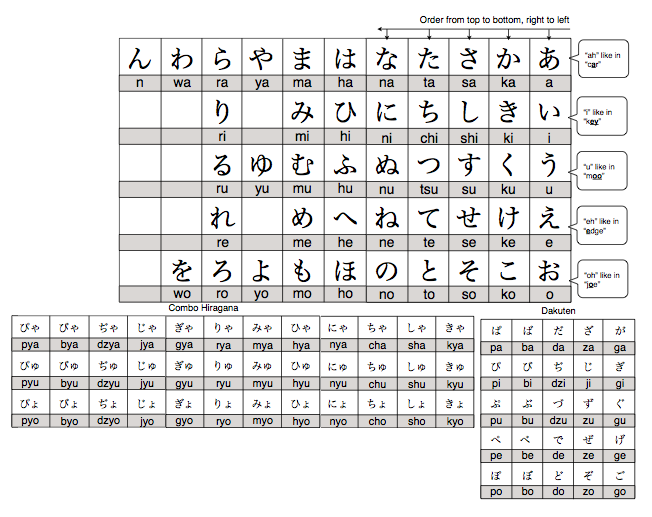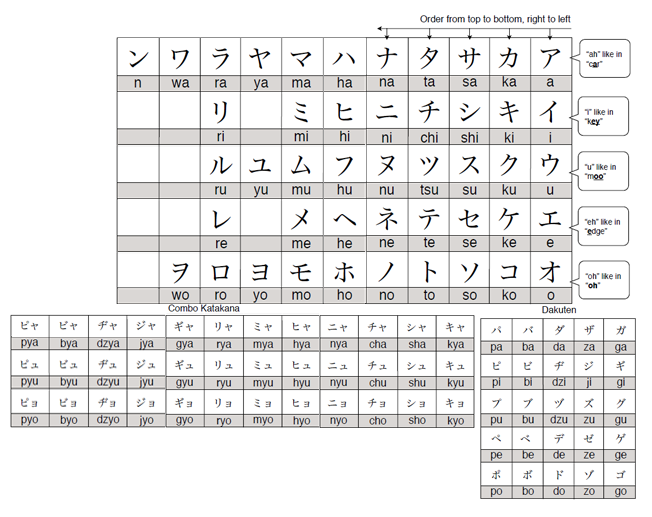| « To Week 1 | ---- | To Week 3 » |
|---|---|---|
Disclaimer: "Kai's Japanese Lessons", along with later "Nihongo Lessons," is not endorsed by an educational supervisor. This form of "education" will not be eligible for school transcripts, etc.
Note: Reading this blog will not, in any way, help you understand the SAO wiki more than you can. However, it may help you define some Japanese terms written with the {{nihongo}} template (but most terms will not be addressed this early in the lessons).
Welcome to Kai Socrius's second Nihongo lesson! This lesson will introduce:
Hiragana Chart[]
Please take the time to memorize the hiragana table. This is the most essential part of the Japanese Language, as all words and syllables are derived from this "alphabet."
Katakana Chart[]
Yes, not just 46 hiragana, but 46 katakana as well. You may have recognized these characters from the previous lesson, in the examples.
Please take the time to memorize the katakana table. Although this portion is not generally needed to learn Japanese, but non-Japanese terms and or modernized terms are written in katakana.
Vocabulary[]
A Few ます-form Verbs[]
| Japanese Character | Japanese pronunciation | English |
|---|---|---|
| します | shimasu | to do (something) |
| 行きます (いきます) | ikimasu | to go (to a place) |
| 来ます (きます) | kimasu | to come (to a place) |
| 話します (はなします) | hanashimasu | to speak |
| 寝ます (ねます) | nemasu | to sleep |
| 言います (いいます) | iimasu | to say |
| 食べます (たべます) | tabemasu | to eat |
| います | imasu | to exist (animate objects) |
| あります | arimasu | to exist (inanimate objects) to have |
| タイプ (を) します (たいぷ (を) します) | taipu (o) shimasu | to type |
| メッセジ (を) します (めっせじ (を) します) | messeji (o) shimasu | to send a message |
| 闘います (たたかいます) | tatakaimasu | to fight |
| 殺します (ころします) | koroshimasu | to kill |
| 死にます (しにます) | shinimasu | to die |
I may or may not go over every single verb I know/learned, as that is somewhat of a waste of time (to me). However, a Japanese Dictionary will suffice in looking for verbs (Google Translate is not very reliable, and I will go over Dictionary Form in this Lesson).
And yeah, the last three were funsies.
Verb Conjugation[]
This form of conjugation covers the conjugation of です (desu) and ます-form verbs. Conjugation with the う-form results in different forms with their own rules.
There are 4 different ます-form conjugations:
- Present affirmative
- Present negative
- Past affirmative
- Past negative
- Note: ます-form verbs typically have a future connotation. However, ます-verbs can be used as present tense verbs, according to context.
です Conjugation[]
です follows this same conjugation despite not being a ます-form verb.
| Present affirmative | Present negative | Past affirmative | Past negative |
|---|---|---|---|
| です (desu) is |
では ありません (dewa arimasen) is not |
でした (deshita) was |
では ありませんでした (dewa arimasendeshita) was not |
ます-form Verb Conjugation[]
The different forms of conjugation all stem from taking the verb stem, which is taken by dropping the ます (masu) from the end of each ます-form verb.
- Present affirmative: Verbs start as "present affirmative"
- Present negative: Drop ます and add ません (masen) to the end of the verb stem
- Past affirmative: Drop ます and add ました (mashita) to the end of the verb stem.
- Past negative: Drop ます and add ませんでした (masendeshita) to the end of the verb stem.
Example using "たべます" (tabemasu) (to eat)
| Present affirmative | Present negative | Past affirmative | Past negative |
|---|---|---|---|
| たべます (tabemasu) I eat. |
たべません (tabemasen) I do not eat. |
たべました (tabemashita) I ate. |
たべませんでした (tabemasendeshita) I did not eat. |
Dictionary Form[]
Before we start, there are a few rules we have to note.
The verbs in the A Few Verbs Section (just above) all end in with -ます ( -masu). This is known as standard form. Dictionary form is also known as "informal form," because it is the form of verbs that Japanese people use in colloquial speech (with a few exceptions that I will not list).
Verbs in Japanese are grouped into 3 categories, Group 1, Group 2, and Group 3. Simple and straightforward? Then here's some trivia and then some more memorization.
- Group 1 Verbs constitute about 75% of Japanese Verbs.
- Group 2 Verbs constitute about 25% of Japanese Verbs.
- Group 3 Verbs only consist of 2 "verb-roots," though there is an unlimited amount of verbs this group can have, since all of Group 3 "Irregular verbs" are not "native Japanese".
Okay: "Mechanics" time. To convert your verb into Dictionary form, you must:
- Look at the last hiragana of your verb stem
- drop the -ます (-masu)
- look at the now-last hiragana
Example
- 1. たべます (tabemasu) (to eat)
- 2. たべ...ます
- 3. たべ...
ます
- Last Hiragana is べ (be). This verb is a Group 2 Verb.
- 4. たべる
Rather, I would just look at the hiragana before the "masu" and then drop the "masu," but that's personal preference.
| Group 1 Verbs | Group 2 Verbs | Group 3 Verbs | |
|---|---|---|---|
| End of Verb Stem Hiragana | い ち り み に び き ぎ し |
Any verb stem ending with an え (e)-sounding hiragana A verb stem that has only one hiragana (aside from the Group 3 verbs) |
します きます |
| Addition at the End of Verb Stem to make Dictionary Form | take corresponding end hiragana's first verb and switch with corresponding う-sounding hiragana Example: いきます (ikimasu) (to go) >> いく (iku)) |
Take off ます (masu) and add る (ru) Example: たべます (tabemasu) (to eat) >> たべる (taberu) Example: ねます (nemasu) (to sleep) >> ねる (neru) |
します (shimasu) >> する (suru) きます (kimasu) >> くる (kuru) タイプ します (taipu shimasu) (to type) >> タイプ する (taipu suru) |
Sentence Structure[]
Structure[]
| Structure | Definition |
|---|---|
| «Noun 1» は «Verb»。 | «Noun 1» «Verb». |
Examples[]
ます-form verbs are above; う-form verbs are below.
| Example | Example pronunciation | English |
|---|---|---|
| わたし は たべます。 わたし は たべる。 |
WATASHI WA TABEMASU WATASHI WA TABERU |
I eat. |
| わたし は ねます。 わたし は ねる。 |
WATASHI WA NEMASU WATASHI WA NERU |
I sleep. |
| えいが を みます。 えいが を みる。 |
EIGA WO MIMASU EIGA WO MIRU |
I see a movie. |
This concludes Lesson One. If you do not fully understand something, please feel free to leave a comment below. I will reply in 24-hour's time.
Apparently, I had a hard time trying to come up with this lesson. Perhaps, one could leave a comment below saying what they wish to learn. Please keep it short, as I don't wish to spend a lot of time on this (and please note that my real-life schedule barely allows me to squeeze this in xD)
では, 次回 まで。 (では、 じかい まで。 // Then, until next time.)
- Kai Socrius (1caiser) (talk)
» To Week 3



